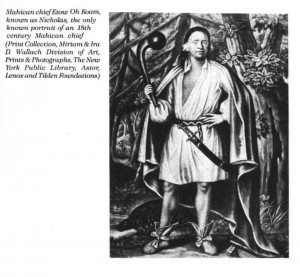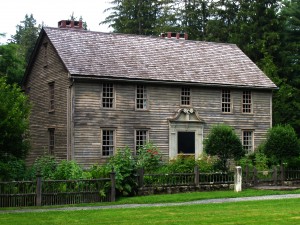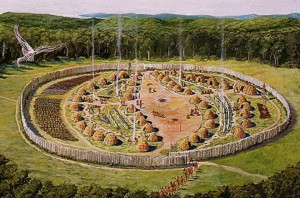The Stockbridge Indian lands included part of what would become Lenox. Why the Stockbridge Indians were here and why they sold their land is an important part of the story of the settlement of the Berkshires. The story is complex and poignant. Blog readers are particularly encouraged, on this topic, to follow up with the many fine books and other sources listed below.
Very briefly
- The Mahicans*, in 1734, found themselves in a difficult situation. Part of the Algonquin linguistic group of Native Americans that extended southward from Canada, the Mahicans had formerly occupied both sides of the Hudson River and their ancestors probably had been among those who watched with amazement in 1609 as Henry Hudson sailed by. They had survived on a combination of limited agriculture and woodland hunting (see Life Berkshire Before Europeans.) By now they had been decimated by disease and changes wrought by the Europeans to their homeland. They were hemmed in by their Mohawk enemies to the west and explosive European expansion to the east. (Various spellings of the tribe’s name have been found — Mohican, Mahican, etc.)

- Although sentiment about Indians, even the Mahicans who had been allies of the English for several generations, was mixed, there was a group of religious leaders who felt obliged to honor what had been part of the original Puritan mission (to bring Christianity to the Native Americans). In addition, it was in the political interest of the English Colonial government to cement Indian allies in their continuing wars with the French and their Indian allies
- Much of modern day Sheffield and Great Barrington had already been sold, by the Mahicans, for colonial settlement
- Consequently, the royal government of Massachusetts and a missionary group agreed to purchase a tract of (est.) 9000 acres north of modern day Great Barrington to establish a mission for the Mahicans and other Native American allies. The agreement was that the Mission would include establishment of minister to teach the gospel to the Indians, a school, and settlement of four English families to lead the Mohicans in learning the ways of Christianity and English life.
- The minister (John Sergeant) who agreed to launch this effort did establish a mission in 1738 and made every effort to live up to the high ideals set for the mission.

- However, despite the high ideals, this agreement with Native Americans, like so many before and after, would be overwhelmed by the Europeans’ lust for land and their sense of entitlement.
- The Mohicans farmed (although the men still thought of it as women’s work), converted to Christianity, went to school, and fought (and died) side by side with their English (and later American) allies. However, the also found themselves with less land or less desirable land than had originally been envisioned (because, among other things more than the four families settled).
- With no source, other than the sale of their land, for exchange for rum (illegal but sold anyway) and trade goods, they sold to the colonials. The land for goods/land for currency exchanges that resulted may have allowed the colonials to feel justified in what they were doing but were, in hindsight, one sided and unfair.
- An example of this one sided trading is highly relevant to the history of Lenox. In 1739, the Indians wanted some 280 acres of meadowland recently sold for 450 pounds. To obtain the meadowlands, the Indians gave up 4,000 acres to the northeast – most of present-day Lenox. The new owners of this extensive woodland included the proprietors of the mission and were: Stephen Williams, Samuel Hopkins, Neimiah Bull, John Sergeant, , Timothy Woodbridge, Ephraim Williams, and John Stoddard’s nephew Jonathan Edwards. Ephraim Williams acquired 900 acres plus a 130 acre pond, Bull 700 acres, and the remainder approximately 480 acres each. (Some pretty sharp Yankee dealing for a bunch of missionaries.)
- Eventually, the Stockbridge Indians found themselves with more and more mouths to feed on less and less land. In 1780, many accepted the invitation of their Oneida cousins to resettle in upstate New York and stayed their long enough for their tales to influence James Fenimore Cooper to write The Last of the Mohicans. The modern day Stockbridge Indians are to be found in Wisconsin where they remain one of only a few tribes that have retained their pre-colonial identity.
See:
To Live Upon Hope, Mohicans and Missionaries in the Eighteenth Century Northeast by Rachel Wheeler
The Mohican World, 1680-1750 by Shirley W. Dunn
Lenox Massachusetts, Shiretown by David Wood
